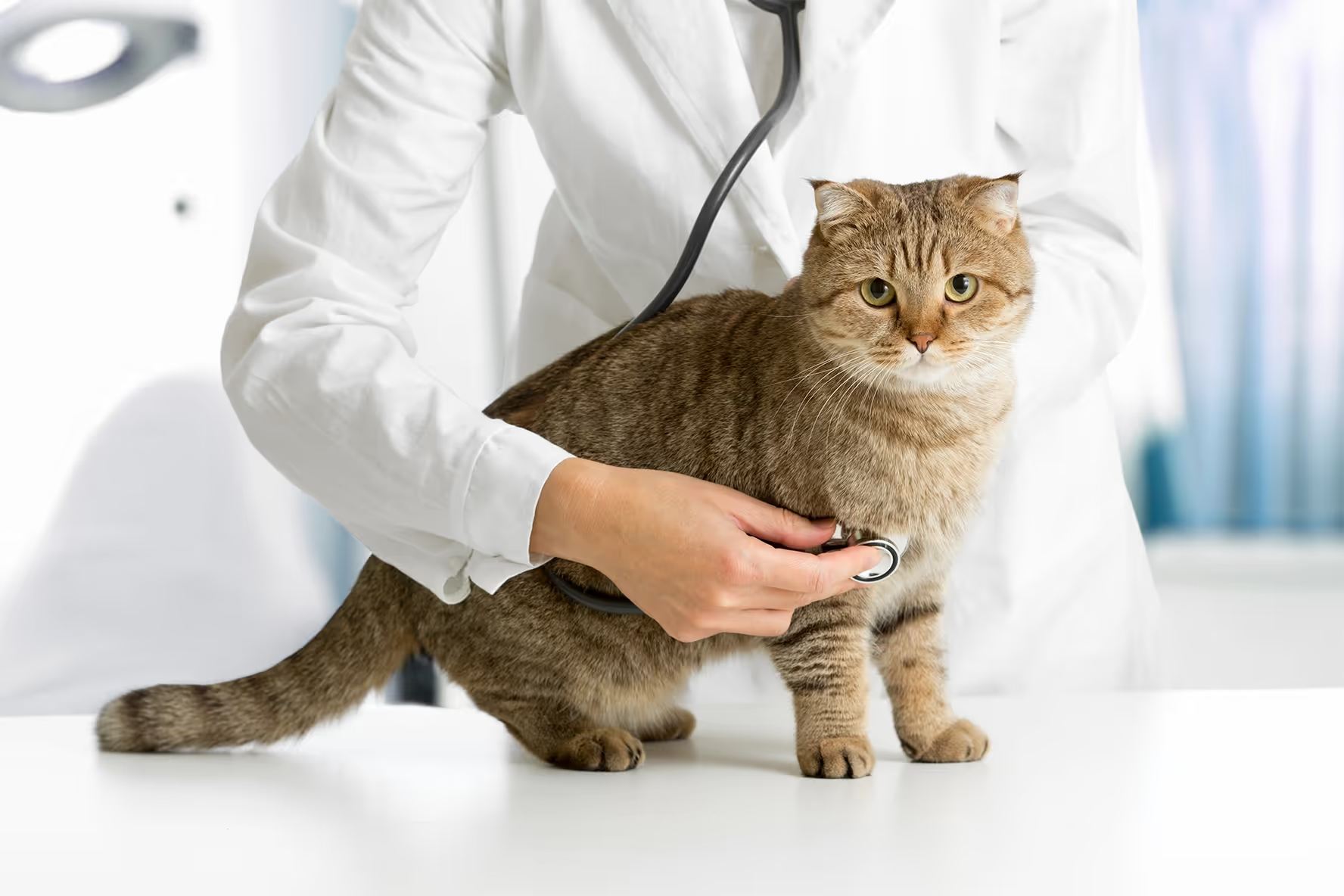
When something is wrong with your pet’s health, the best thing to do is to bring them to the vet. General health worries are always worth at least talking to your vet about, but some symptoms can lead to discovering news that you would never have wanted to hear.
Symptoms of lymphoma in cats
Symptoms that come along with feline lymphoma can mimic other common cat illnesses. Different types of lymphoma in cats will have different symptoms, but between all of the variations, the most common signs that something is wrong are weight loss, lethargy or loss of energy, and lack of appetite.
Depending on the location where the lymphoma is developing, there may also be some of the following symptoms.1,2,3,4
Gastrointestinal lymphoma symptoms
These symptoms tend to have a more rapid onset within a few days or weeks if the lymphoma is a large cell variation. While small cell variations may take months.
- Vomiting
- Diarrhea
- Distended abdomen
- Nausea
- Weight loss and decreased appetite
Mediastinal lymphoma symptoms
- Sudden onset of difficulty breathing
- Lower energy
- Decreased appetite
- Occasional regurgitation
Renal lymphoma symptoms
Symptoms are often linked with kidney failure.
- Increased thirst
- Increased urination
- Vomiting
- Possible signs connected to the central nervous system such as behavior changes, seizures, difficulty walking, etc
External lymphoma (external lymph nodes involved)
- Lumps or swellings around the body
How is feline lymphoma diagnosed?
There are several common tests performed to diagnose lymphoma in pets. Additionally, it is often the expectation that testing for one diagnosis will help to rule out any other possible causes, so a veterinarian may choose to perform additional tests than those discussed here. It is not uncommon to expect a pet to go through standard blood work when they come in with an unclear ailment.
Lymphoma can only be diagnosed when cancerous cells are identified on a microscopic level, so samples of the affected cells will need to be gathered to perform a microscopic examination. In some cases, finding the safest way to approach the affected cells is the first step; some patients may need an abdominal ultrasound to locate the best area to gather samples from and choose the safest method to gather cells from there.5
The most common method for collecting these sample cells is through a Fine Needle Aspirate (FNA). With this method, your vet will take a small needle and insert it into an affected area—either an external lymph node or, if they can safely get access to, an internal area, such as an enlarged portion of the intestines, fluid in the chest cavity, swollen kidney tissue, etc. Once at the chosen sample area, they will use an empty syringe to pull some of the fluid out to examine it under a microscope.6
If an FNA is not a viable method for gathering sample cells, then a surgical biopsy can be performed. This can be a common method for cats that may have gastrointestinal lymphoma in an area that is not safe to reach with a needle alone; they may need surgery to open their abdomen to remove a small sample of the affected tissue. Another method that may be used is endoscopy—the use of a small camera and specialized tools to gather a sample of the interior portion of the intestines.7
Specialized tests for Lymphoma
Should cancer be found in the samples removed, your vet may also want to run supplemental tests to identify what type of cells are being affected by lymphoma. This helps to provide a more accurate understanding of the illness and will allow your veterinarian to choose more effective treatments.
Practices like immunophenotyping and immunohistochemistry help your veterinary oncologist in gathering all of the diagnostic information needed to create the best treatment plan for your cat. Tests like flow cytometry (FCM) and PCR for antigen receptor rearrangements (PARR), when combined with morphological evaluation, not only aid in the diagnosis but also provide prognostic information by classifying lymphoma. Additionally, the immunophenotyping assays are extremely useful for confirming a diagnosis in ambiguous cases and emerging lymphomas.
These tests can mean a world of difference when it comes to your veterinary oncologist developing a treatment plan, as a majority of feline lymphoma cases will be treated with chemotherapy. Choosing the correct chemotherapy medication, combination, dosage, and treatment schedule relies heavily on knowing what kind of cells are affected, as some will need a faster, more aggressive treatment plan and others may not react well to that kind of approach.
Flow Cytometry (FCM)
A flow cytometry test is performed with an instrument called a flow cytometer. This machine stains the live cancer cells with fluorescently labeled antibodies, which bind to specific cell surface proteins, thus labeling the cell. The machine then sends those labeled cells through a light source where the fluorescent intensity can be detected by the instrument. The intensity means that there is the presence of a specific surface marker.
These results can make up all or part of an immunophenotype, helping your vet to create an effective treatment plan.
PCR for Antigen Receptor Rearrangements (PARR)
Polymerase Chain Reaction (PCR) for Antigen Receptor Rearrangements is a molecular test that amplifies DNA from the suspected specimen and assesses the variable regions of B- and T-cell receptors. Using the PARR test, the diagnostic lab looks closely for a single peak or single band that clearly shows you whether it’s a B-clonality or T-clonality, which means the patient has cancer, and in this case, lymphoma or leukemia is detected in the patient.
B- and T-cell lymphomas behave differently, have varied clinical outcomes, and therefore react differently to various treatment plans. Knowing which type of lymphoma your pet has is the first step in finding the best treatment for their specific case.8
ImpriMed is working hard to offer pet parents support with feline lymphoma
ImpriMed has successfully developed a system that helps dogs with canine lymphoma and is now working hard to build up that same system for cats, but needs help to get enough data to offer effective help to cat parents out there.
Immunophenotyping is one of the first steps your vet takes to find the best treatment option for your pet. It comes shortly after identifying that there are cancerous cells in the body.
Find out more about our Immunoprofile for feline lymphoma and leukemia
REFERENCES:
- https://avim.us/lymphoma-in-cats/
- https://hospital.cvm.ncsu.edu/services/small-animals/cancer-oncology/oncology/feline-lymphoma/
- https://petcureoncology.com/lymphoma-in-cats/
- https://pets.webmd.com/cats/what-to-know-about-lymphoma-in-cats
- https://vcahospitals.com/know-your-pet/lymphoma-in-cats#:~:text=How%20is%20lymphoma%20diagnosed%3F,of%20your%20cat's%20clinical%20signs
- https://pets.webmd.com/cats/what-to-know-about-lymphoma-in-cats
- https://hospital.cvm.ncsu.edu/services/small-animals/cancer-oncology/oncology/feline-lymphoma/
- https://www.imprimedicine.com/blog/testing-for-canine-lymphoma


